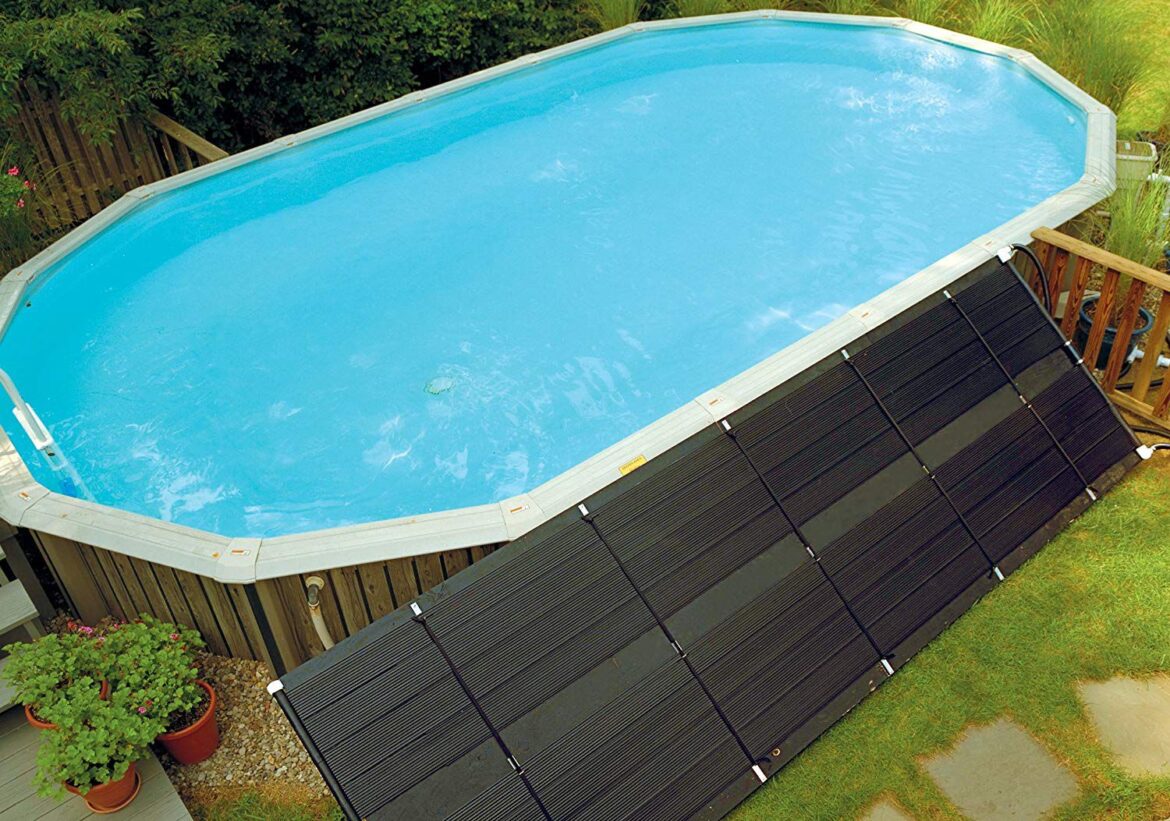290
A pool in the garden is a real highlight, but often the water is too cold for a relaxing swim—however, there are various ways to heat it effectively. There are inexpensive DIY solutions and professional heating systems.
Heating pool water with the sun and a cover
When heating pool water, smart use of space and consistent insulation quickly pay off.
- Dimension solar absorbers correctly: Install mat or tube collectors with a surface area that is at least half, or better three-quarters, of the water surface; this allows the system to transfer up to 0.6 kWh of heat per square meter on a clear June day. Mount the elements at a 25–35° angle facing south, lay out the pipe route with an inner diameter of 32 mm, and connect a three-way bypass so that sensors only direct the water over the roof when the return flow is more than 3 K (Kelvin) cooler.
- Solar tarpaulin + solar mat as a heat duo: Combine a 400 µm bubble tarpaulin with the absorber: during the day, the mat absorbs radiation and sends up to 5 K into the circuit; at night, the floating film retains up to 95% of this energy in the pool; at the same time, evaporation is drastically reduced. This means that a short filter run in the morning is sufficient to distribute the heated water evenly.
- Use the cover consistently: Roll the tarpaulin back over the water immediately after swimming. A sturdy hand or solar reel makes daily handling easier, and the tarpaulin lasts four to five seasons thanks to UV stabilizers. In wind speeds of 25 km/h or more, tension straps secure the edge to prevent cold air from getting underneath.
- Adjust pump operation to the sun: Set the speed-controlled filter pump to low speed (approx. 1,000 rpm) between 11 a.m. and 4 p.m. The slower flow rate is sufficient to feed the absorber, saves up to 60% electricity compared to full load and reduces noise.
- Vent the collector in spring: Briefly open the upper collection pipe until water flows out without bubbles. Trapped air would reduce heat transfer and create hot spots that cause the plastic to age.
- Erect wind protection: Install a 1.6 m high polycarbonate wall on the weather side. Even a 5 km/h reduction in wind speed halves convective losses; the water hardly cools down at night.
Technology for constant temperature
A weather-independent heating system supplements the solar heat and keeps the pool stable during cool weeks.
- Choose a heat pump that is suitable for the pool volume: Calculate approximately 5 BTU (British Thermal Unit) per liter of water; a 40 m³ pool therefore requires around 200,000 BTU ≈ 12 kW of heating power. In practice, manufacturers of pool heat pumps specify the heating power in BTU per hour (BTU/h).
- Make sure you choose a device whose manufacturer clearly states the maximum volume, otherwise the pump will run for a long time and inefficiently. Heat pumps work most effectively when the air temperature is above 20 °C; therefore, it is best to plan operation during the day and connect the controller to the pool cover.
- Use heat-cool models for midsummer: Reversible devices reverse the cooling cycle and lower the water temperature on hot days. This is gentler on children’s skin and prevents algae blooms at a water temperature of 30°C.
- Electric pool heating for small pools: A 3 kW instantaneous water heater is inexpensive to purchase but consumes exactly 3 kWh of electricity per operating hour; at 0.30 €/kWh, that’s 0.90 € per hour. This makes the device particularly worthwhile for temporary paddling pools up to around 10 m³, which are only heated at weekends.
- Connecting heat exchangers to the house heating system: A stainless steel plate heat exchanger transfers the energy from the building’s gas, oil, or air heat pump. Run the primary side with a 60°C flow, instant adhesive seal, and separate circulation pump; the exchanger then provides an increase of around 2 K per hour for 40 m³ of water.
- Cover saves energy and chemicals: The tarpaulin not only reduces heat loss, but also reduces evaporation by up to 95%. This means that the water stays in the pool longer, eliminating the need to refill with fresh water and add salt to the chemicals; you reduce operating and heating costs in equal measure.
- Retrofit pool insulation: If you are digging up the ground around the pool anyway, stick 50 mm XPS panels to the outside of the walls and floor. The additional insulation significantly reduces heating times and the running time of the heating source.

